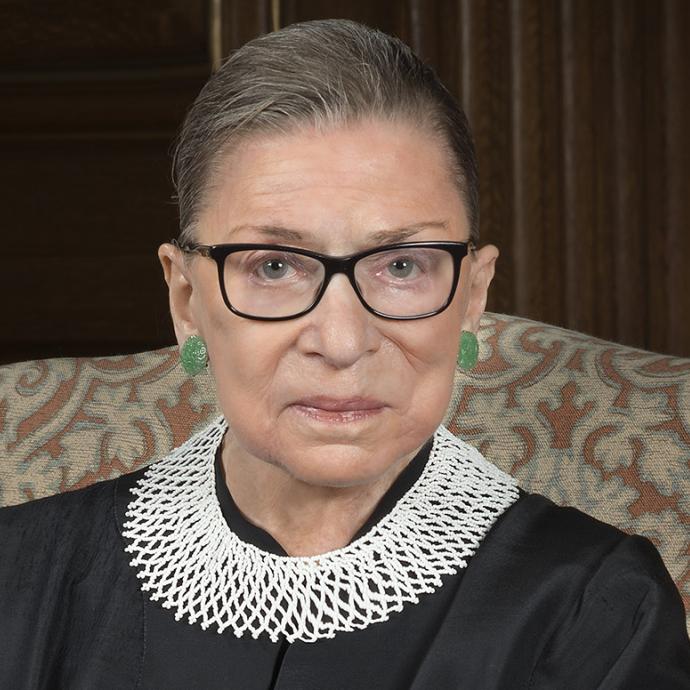United States Supreme Court Justice Ruth Bader Ginsburg, popularly known and called “Notorious RBG” by Americans, a champion of women’s rights and the court’s leading liberal voice, has died at the age of 87.
Ginsburg died of complications from metastatic pancreas cancer at her home in Washington, DC, surrounded by her family, the court said in a statement on Friday evening.
“Our nation has lost a jurist of historic stature,” Chief Justice John Roberts said in the statement.
“We at the Supreme Court have lost a cherished colleague. Today we mourn, but with confidence that future generations will remember Ruth Bader Ginsburg as we knew her – a tireless and resolute champion of justice.”
Flags outside the White House and Supreme Court in the US capital were lowered to half-staff Friday evening after Ginsburg’s death was announced.
Hundreds of people also gathered outside the Supreme Court to mourn her passing and tributes poured in from politicians, celebrities, athletes and many others, who hailed Ginsburg as a liberal icon who paved the way for women. Ginsburg was a giant of American jurisprudence and a stalwart defender of women’s and voting rights.
She was appointed to the Supreme Court in 1993 by then US president Bill Clinton – becoming only the second woman ever to serve on the court.
In recent years, Ginsburg became a popular culture icon known as the “Notorious RBG”. She was the subject of a feature film, On the Basis of Sex, and a 2018 documentary film on her life and legal career.
“I ask no favour for my sex. All I ask of our brethren is that they take their feet off our necks,” Ginsburg said in the documentary, Reuters reported, summing up her lifelong work towards gender equality.
Joan Ruth Bader was born in the New York City borough of Brooklyn. Her father Nathan was a Jewish emigrant from Odessa, Ukraine, and her mother, Celia was born in New York to Austrian Jewish parents.The family called Joan Ruth “Kiki”, a nickname Marylin had given her for being “a kicky baby”.
When “Kiki” started school, Celia discovered that her daughter’s class had several other girls named Joan, so Celia suggested the teacher call her daughter “Ruth” to avoid confusion. Although not devout, the Bader family belonged to East Midwood Jewish Center, a Conservative synagogue, where Ruth learned tenets of the Jewish faith and gained familiarity with the Hebrew language.
At age 13, Ruth acted as the “camp rabbi” at a Jewish summer program at Camp Che-Na-Wah in Minerva, New York. Celia took an active role in her daughter’s education, often taking her to the library. Celia had been a good student in her youth, graduating from high school at age 15, yet she could not further her own education because her family instead chose to send her brother to college. Celia wanted her daughter to get more education, which she thought would allow Ruth to become a high school history teacher.
Ruth attended James Madison High School, whose law program later dedicated a courtroom in her honor. Celia struggled with cancer throughout Ruth’s high school years and died the day before Ruth’s high school graduation.
Bader attended Cornell University in Ithaca, New York and was a member of Alpha Epsilon Phi. While at Cornell, she met Martin D. Ginsburg at age 17. She graduated from Cornell with a bachelor of arts degree in government on June 23, 1954. She was a member of Phi Beta Kappa and the highest-ranking female student in her graduating class. Bader married Ginsburg a month after her graduation from Cornell. She and Martin moved to Fort Sill, Oklahoma, where he was stationed as a Reserve Officers’ Training Corps officer in the Army Reserve after his call-up to active duty.
At age 21, she worked for the Social Security Administration office in Oklahoma, where she was demoted after becoming pregnant with her first child. She gave birth to a daughter in 1955.
In the fall of 1956, Ginsburg enrolled at Harvard Law School, where she was one of only nine women in a class of about 500 men.The Dean of Harvard Law reportedly invited all the female law students to dinner at his family home and asked the female law students, including Ginsburg, “Why are you at Harvard Law School, taking the place of a man?
When her husband took a job in New York City, Ginsburg transferred to Columbia Law School and became the first woman to be on two major law reviews: the Harvard Law Review and Columbia Law Review. In 1959, she earned her law degree at Columbia and tied for first in her class
At the start of her legal career, Ginsburg encountered difficulty in finding employment. In 1960, Supreme Court Justice Felix Frankfurter rejected Ginsburg for a clerkship position due to her gender. She was rejected despite a strong recommendation from Albert Martin Sacks, who was a professor and later dean of Harvard Law School. Columbia Law Professor Gerald Gunther also pushed for Judge Edmund L. Palmieri of the U.S. District Court for the Southern District of New York to hire Ginsburg as a law clerk, threatening to never recommend another Columbia student to Palmieri if he did not give Ginsburg the opportunity and guaranteeing to provide the judge with a replacement clerk should Ginsburg not succeed. Later that year, Ginsburg began her clerkship for Judge Palmieri, and she held the position for two years.
From 1961 to 1963, Ginsburg was a research associate and then an associate director of the Columbia Law School Project on International Procedure; she learned Swedish to co-author a book with Anders Bruzelius on civil procedure in Sweden. Ginsburg conducted extensive research for her book at Lund University in Sweden. Ginsburg’s time in Sweden also influenced her thinking on gender equality. She was inspired when she observed the changes in Sweden, where women were 20 to 25 percent of all law students; one of the judges whom Ginsburg watched for her research was eight months pregnant and still working.
Her first position as a professor was at Rutgers Law School in 1963. The appointment was not without its drawbacks; Ginsburg was informed she would be paid less than her male colleagues because she had a husband with a well-paid job. At the time Ginsburg entered academia, she was one of fewer than 20 female law professors in the United State. She was a professor of law, mainly civil procedure, at Rutgers from 1963 to 1972, receiving tenure from the school in 1969.
In 1970, she co-founded the Women’s Rights Law Reporter, the first law journal in the U.S. to focus exclusively on women’s rights. From 1972 to 1980, she taught at Columbia Law School, where she became the first tenured woman and co-authored the first law school casebook on sex discrimination. She also spent a year as a fellow of the Center for Advanced Study in the Behavioral Sciences at Stanford University from 1977 to 1978.
In 1972, Ginsburg co-founded the Women’s Rights Project at the American Civil Liberties Union (ACLU), and in 1973, she became the Project’s general counsel. The Women’s Rights Project and related ACLU projects participated in more than three hundred gender discrimination cases by 1974. As the director of the ACLU’s Women’s Rights Project, she argued six gender discrimination cases before the Supreme Court between 1973 and 1976, winning five. Rather than asking the court to end all gender discrimination at once, Ginsburg charted a strategic course, taking aim at specific discriminatory statutes and building on each successive victory. She chose plaintiffs carefully, at times picking male plaintiffs to demonstrate that gender discrimination was harmful to both men and women. The laws Ginsburg targeted included those that on the surface appeared beneficial to women, but in fact reinforced the notion that women needed to be dependent on men. Her strategic advocacy extended to word choice, favoring the use of “gender” instead of “sex”, after her secretary suggested the word “sex” would serve as a distraction to judge. She attained a reputation as a skilled oral advocate, and her work led directly to the end of gender discrimination in many areas of the law.
Ginsburg was nominated by President Jimmy Carter on April 14, 1980, to a seat on the United States Court of Appeals for the District of Columbia Circuit vacated by Judge Harold Leventhal after his death. She was confirmed by the United States Senate on June 18, 1980, and received her commission later that day.
President Bill Clinton nominated Ginsburg as an Associate Justice of the Supreme Court on June 14, 1993, to fill the seat vacated by retiring Justice Byron White. She was recommended to Clinton by then–U.S. Attorney General Janet Reno, after a suggestion by Utah Republican Senator Orrin Hatch.At the time of her nomination, Ginsburg was viewed as a moderate. Clinton was reportedly looking to increase the court’s diversity, which Ginsburg did as the only Jewish justice since the 1969 resignation of Justice Abe Fortas. She was the second female and the first Jewish female justice of the Supreme Cour She eventually became the longest-serving Jewish justice. The American Bar Association’s Standing Committee on the Federal Judiciary rated Ginsburg as “well qualified”, its highest possible rating for a prospective justice.
Dear readers, we really need your support to keep on serving you with authoritative, truthful, and juicy stories everyday. For your support, please reach out to the editor @gavelinternational66@gmail.com

